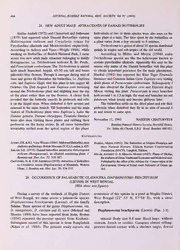
New adult male attractants of danaid butterflies PDF
Preview New adult male attractants of danaid butterflies
466 JOURNALBOMBAYNATURAL HIST SOCIETY, Vol.91 (1994) 28. NEWADULT MALE ATTRACTANTS OFDANAID BUTTERFLIES EarlierAmladi(1975) and Chaturvediand Satheesan Individuals oftwo or three species were also seen on the (1979) had reported adult Danaid Butterflies visiting same plantatatime. The time spent bythe butterflies on Heliotropium indicum and Crotalaria retusa for a plant varies from afew seconds to 8 mintues. Pyrrolizidine alkaloids and Mono—cretolene respectively. Trichodesmaisagenusofabout35 speciesdistributed According to Ackery and Vane Wright 1984), while mainly in tropics and sub-tropics ofthe old world. working on Butterflies of Borivli National Park, I came According to Miller and Morris (1988) some across two new adult male attractant belonging to family Trichodesma species are like the heliotropes known to Boraginaceae, i.e. Trichodesma indicum R. Br. Prodr., contain pyrrolizidine alkaloids. Apparently this may be the andParacaryum coelestinum. The Trichodesma isannual reason whymales ofthe Danaid butterflies visit this plant herb much branched, hispid, 45-50 cm tall and bears to obtain important precursor for the male phermones. palevioletblue flowers. Though it emerges during mid of Haribal (1992) has reported the Blue Tiger Tirumala June and grows tillDecember the butterflies, i.e. Euploea liminiaceandCommon IndianCrowEuploea corevisiting core, and Euploea klugii visit this plantin late august till dried plants ofParacaryum coelestinum. Subsequently I October. On 23rd August I saw Euploea core hovering had also observed the Euploea core and Euploea klugii around the Trichodesma plant and alighting near the top Moore visiting this plant. Paracaryum is erect branched of the plant rather than on the flowers. A closer look herbaround 1 to 1.5mhigh, thestemandbranchesarered revealed that the butterfly uncoils its proboscis and rubs pubescent when young and become glabrous later. it on the hispid stem. When disturbed it flew around and The butterflies settle on the dried plantandrub their returned to the same branch. TillSeptemberend themain proboscis when disturbed they fly in an area ofaround 4 m visitors of Trichodesma plant were Euploea's. Later the and return to same spot. Danaus genutia, Danaus chrysippus, Tirumala limniace were also seen visiting these plants and rubbing their November 11, 1993 NARESH CHATURVEDI proboscis on the hairy stems. In all cases butterflies BombayNaturalHistorySociety, HombillHouse, invariably settled near the apical region of the plant. Dr. SalimAliChowk,S.B.S. Road, Bombay400023. References Ackery,P.R.&R.I.Vane-Wright(1984):MilkweedButterflies,their Haribal,Meena(1992):TheButterfliesofSikkimHimalayaand cladisticsandbiology.BritishMuseum(N.H.),London,p.425. their Natural History. Sikkim Nature Conservation Amladi,S.R.(1975):DanaidbutterfliesattractedtoHeliotropium Foundation(SNCF),Gangtok,Sikkim. indicum (Boraginaceae), an alkaloid containing plant. J. Miller,AnthonyG.&MirandaMorris (1987):PlantsofDhofar, Bombaynot.Hist.Soc. 72: 535-587. thesouthernofOmanTraditionalEconomicandMedicinaluses. Chaturvedi,N.& S.M.Satheesan(1979):AttractionofButterflies PublishedbytheofficeoftheAdviserfor Conservationofthe to Crotalaria retusa (Papilionaceae) at Khandala, Western Environment, DiwanofRoyal courtSultanateofOman, pp. Ghats.J.Bombaynat.Hist.Soc. 76: 534-535. 361. 29. OCCURRENCE OF PALAEARCTTC CLADOCERA DIAPHANOSOMA BRACHYURUM (LIEVEN) IN WEST BENGAL (With three text-figures) During a survey of the wetlands ofHughly District occurrence of this species in apond at Hughly District, of West Bengal, we came across a palaearctic species West Bengal (22° 53’ N, 87°56’ E), with a short Diaphanosoma brachyurum (Lieven), of the family description. Sididae. Three species of the genus Diaphanosoma, viz. D. senegalinsis, D. excisum and D. sarsi (Michael and Diaphanosoma brachyurum (Lieven) (Figs. 1-3) Sharma 1988) have been reported from India, Brehm (1936) reported the present species from Kashmir. female: Body size 8.8 mm. Head large, without Subsequent record of this species is from Bangladesh rostrum, fornix or ocellus. Carapace almost oblong; (Khan et al. 1988). The present study reports the postero-dorsal corner with a distinct angle, dorsal
